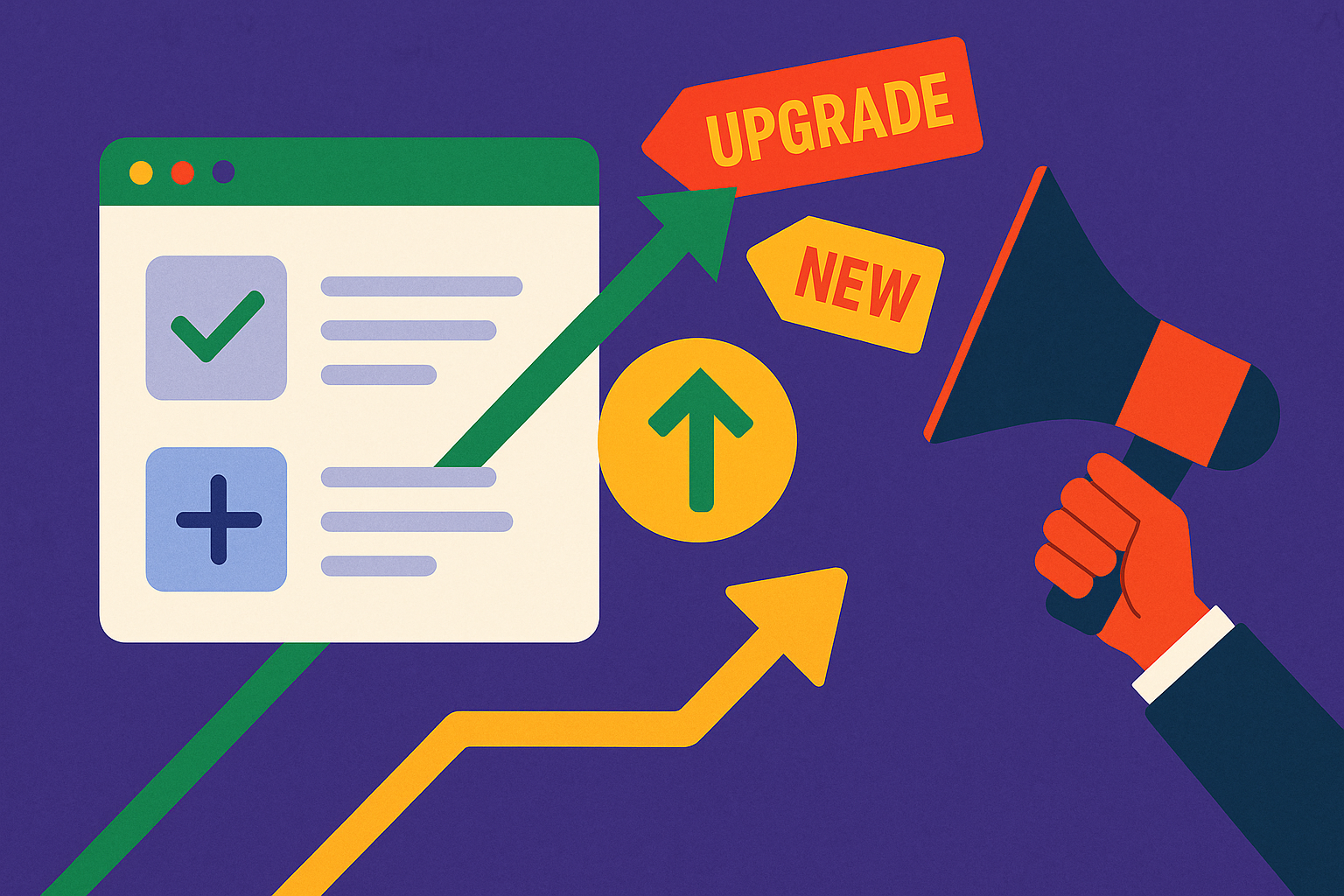Key Takeaways
- A successful feature launch involves more than shipping code; it’s about driving adoption and delivering value.
- Follow this 15-step checklist to ensure your launches are user-focused and data-driven.
- Tools like SimpleDirect can help streamline changelog communication and improve feature adoption.
Introduction
Launching a new feature can feel like a make-or-break moment for product teams. You’ve spent weeks (or months) designing, coding, testing, and iterating.
Now, it’s time to debut your hard work. But here’s the reality: even the best features can flop if they’re not launched effectively.
Without a clear plan, users may not notice your feature, or worse—they might find it confusing and flood your support team with tickets.
A successful feature launch requires more than good code; it requires strategic communication, thoughtful onboarding, and data-driven follow-through.
In this guide, we’ll walk you through a 15-step feature launch checklist to maximize your impact.
Whether you’re managing a small SaaS team or scaling a global product, these steps will help you ensure your launch is a success.
Why a Feature Launch Checklist Matters
Let’s say you’ve just released a new feature. What happens next?
- Scenario A: Users love it, adoption rates climb, and your team celebrates a win.
- Scenario B: Users don’t even notice the feature, or they find it too confusing to use.
The difference comes down to preparation. According to a 2023 study by Product-Led Growth Hub, 60% of product features go underutilized because users don’t understand their value.
Here’s what’s at stake:
| Potential Pitfall | Impact on Your Product |
|---|---|
| Low feature adoption | Wasted development resources |
| Confusion or frustration among users | Increased churn and support tickets |
| Missed marketing opportunities | Lower engagement and fewer new user signups |
On the flip side, a well-executed launch can drive 30-50% higher adoption rates within the first month (source: Mixpanel).
With that in mind, let’s dive into the checklist.
The 15-Step Feature Launch Checklist

1. Define the Problem You’re Solving
Every successful feature starts with one question: What problem are we solving? If you can’t answer this clearly, you risk building something users don’t need.
- Example: Your users struggle to track project deadlines. You’re introducing an automated reminder feature to solve this.
Pro Tip: Use tools like Typeform or Hotjar to collect user feedback and validate the demand for your feature.
2. Set Clear Success Metrics
Define how you’ll measure your feature’s success. This ensures your team focuses on outcomes, not just outputs.
Common metrics include:
- Adoption rate: Percentage of users who engage with the feature (e.g., 25% within the first 30 days).
- Engagement metrics: Time spent using the feature or frequency of use.
- Support impact: Reduction in tickets related to the problem your feature solves.
Example: For a feature aimed at reducing support tickets, set a goal to decrease related tickets by 15% in the first quarter.
3. Build a Target User Persona
Not every user will care about your new feature. Identify your target audience and tailor your messaging to them.
| Persona Attribute | Example |
|---|---|
| Role | Product Manager |
| Pain Point | Struggling to communicate feature updates to users |
| Preferred Channel | Email and in-app messages |
Pro Tip: Focus on the 20% of users who will generate 80% of the feature’s impact.
4. Create a Pre-Launch Communication Plan
Build anticipation before your feature goes live. According to a 2024 report by HubSpot, pre-launch campaigns can increase feature adoption by 40%.
Key pre-launch actions:
- Email teasers: Announce that something exciting is coming.
- Social media: Share sneak peeks or behind-the-scenes updates.
- Beta testing: Invite power users to test the feature early and provide feedback.
5. Test, Test, Test
Nothing derails a feature launch faster than bugs or a poor user experience. Before launch, rigorously test the feature:
- Conduct internal QA with your team.
- Run usability tests with a small group of users.
- Fix bugs and refine the user interface (UI).
6. Write a User-Centric Changelog
Your changelog is your chance to showcase the value of the feature. Use simple, user-focused language, and include visuals.
Example Changelog Entry:
New Feature: Automated Reminders!
Never miss a deadline again—enable reminders in your settings to stay on top of projects.

7. Prepare Internal Teams
Your internal teams—support, sales, marketing, and product—need to be fully aligned on the launch.
| Team | What They Need to Know |
|---|---|
| Support | FAQs, troubleshooting tips, and feature documentation |
| Sales | Use cases and the feature’s value proposition |
| Marketing | Messaging, visuals, and promotional plans |
8. Build an Onboarding Flow
Help users adopt the feature by designing a smooth onboarding experience.
Best Practices:
- Use in-app tooltips or walkthroughs.
- Highlight the feature in your dashboard.
- Send a follow-up email with a step-by-step guide.
9. Write a Compelling Announcement
Your announcement should grab attention and explain the feature’s value.
- Where to Announce:
- Email campaigns
- Blog posts
- In-app notifications
- What to Include:
- The problem the feature solves
- How to use it
- Visuals like screenshots or GIFs
10. Leverage Multiple Channels
Promote the feature across all relevant channels to maximize reach.
| Channel | Example Strategy |
|---|---|
| Target active users with personalized messages | |
| Social Media | Use hashtags, testimonials, and short videos |
| Blog | Publish a detailed post explaining the feature |
| In-App Notifications | Prompt users to try the feature directly in your app |
11. Offer Exclusive Access to Power Users
Engage your most loyal users by giving them early access to the feature. This builds excitement and generates valuable feedback.

12. Monitor User Adoption in Real-Time
Track how users interact with the feature post-launch. Use tools like Mixpanel or Amplitude to analyze:
- Adoption rates
- Drop-off points in the user journey
- Engagement metrics
Example Insight: If 40% of users enable the feature but only 10% actively use it, your onboarding flow may need improvement.
13. Collect User Feedback
Gather feedback to understand what’s working and what isn’t. Use:
- In-app surveys
- Net Promoter Score (NPS)
- A dedicated feedback form
14. Iterate and Improve
Use the feedback and analytics data to refine the feature. Communicate updates to users via your changelog to show you’re listening.
15. Celebrate and Share Success
Once the feature is live and gaining traction, celebrate with your team and community.
| Action | Example |
|---|---|
| Share success metrics | “Over 1,000 users enabled the feature in 2 weeks!” |
| Highlight testimonials | Publish positive user feedback in your marketing |
| Thank users | Acknowledge beta testers and early adopters |
Real Example: How SimpleDirect Does It
When SimpleDirect launched its changelog API integration, we followed this checklist to ensure success:
- Pre-launch teasers increased interest by 30%.
- An intuitive onboarding flow led to a 40% adoption rate in the first month.
- Real-time analytics revealed drop-offs, enabling us to refine the user experience.
The result? A smoother changelog process for users and a significant reduction in support tickets.
Next Steps
- Download this checklist and adapt it to your team’s workflow.
- Identify the feature you want to launch next and start building your pre-launch plan.
- Try SimpleDirect to simplify changelog communication and ensure your users never miss an update.
Your features deserve to shine. Follow this guide, and you’ll turn launches into wins—every time.






